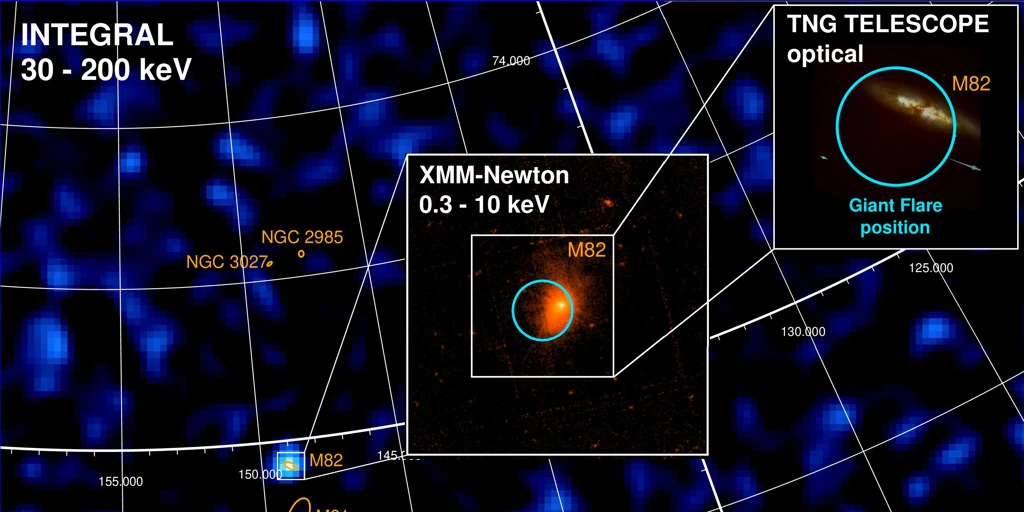This is the first time they have observed a “magnetar” outside our galaxy.

In November 2023, the European orbiting gamma-ray observatory Integral, with which ESA observes some of the most violent phenomena in the Universe, discovered the sudden explosion of a strange object that immediately attracted the attention of astronomers. For just a tenth of a second, instruments detected a brief but intense glow of gamma rays that appeared to be coming from M82, a bright galaxy close to our Milky Way. But it wasn’t a flash like the others.
The data was obtained at the mission’s Science Data Center in Geneva. And from there, just 13 seconds after discovery, an alarm was triggered in observatories around the world. At the same time, IBAS (Integral Burst Alert System) software automatically identified a location that coincided with the nearby galaxy M82, which is “only” about 11.4 million light-years away from Earth. From that moment on, astronomers had to figure out what happened. Was it an ordinary gamma-ray burst or something rarer and more special?
“Special” explosion
“Immediately,” explains Sandro Mereghetti from the National Institute of Astrophysics (INAF-IASF) in Milan and lead author of a paper recently published in the journal Nature, “we realized that this was a special alarm. Gamma-ray bursts come from far away places and from anywhere in the sky, but this burst came from a specific, close and bright galaxy.”
To find out what exactly they were dealing with, the team asked ESA’s XMM-Newton space telescope to conduct a follow-up observation of the flare’s location as soon as possible. If this were the classic short burst of gamma rays caused by the collision of two neutron stars, the collision would also create gravitational waves and be accompanied by a glow in X-rays and visible light.
But XMM-Newton observations showed only the galaxy’s hot gas and stars. And no source of X-rays or gravitational waves coming from the location where the glow was detected.
“Using ground-based optical telescopes, including the Italian Telescopio Nazionale Galileo and the French Observatory of Haute-Provence,” continues Mereghetti, “we looked for a signal in visible light, starting just a few hours after the explosion, but again found nothing. In the absence of a signal in X-rays or visible light, and in the absence of gravitational waves measured by various detectors on Earth (LIGO/VIRGO/KAGRA), we are confident that the signal came from a magnetar.”
An artistic representation of a magnetar, the cosmic object with the strongest magnetic fields in the Universe.
WHAT
extreme object
A magnetar is a type of neutron star, but with a much stronger magnetic field. A neutron star is the stellar corpse left behind when very massive stars, more than eight solar masses, explode as supernovae. In these cases, the explosion may leave behind not only a black hole, but also a neutron star, the unusually dense core of a star, the size of a small city, but so compact that it contains more mass than neutron stars, which spin very quickly. towards themselves and have strong magnetic fields. Some of them, the youngest, have unusually strong magnetic fields, more than 10,000 times stronger than a typical neutron star, and emit gigantic bursts of energy. These are magnetars.
However, over the past half century of observations of gamma rays, only three giant magnetar flares have been observed in our galaxy. And no one outside of it. In all cases, these are very strong bursts: one of them, discovered in 2004, occurred 30,000 light years from Earth, but was still powerful enough to affect our planet’s upper atmosphere in the same way that solar flares do. much closer, just 8 light minutes away.
An image of M82, a bright galaxy undergoing intense star formation, taken by the Hubble Space Telescope.
NASA, ESA and Hubble Legacy Team (STScI/AURA)
First extragalactic magnetar
“The flare detected by Integral,” says Mereghetti, “is the first confirmation of the existence of a magnetar outside the Milky Way. “We suspect that some of the other ‘short gamma-ray bursts’ observed by Integral and other satellites may also be giant magnetar flares.”
Thus, this discovery is a kind of “starting flag” for the search for new extragalactic magnetars. According to ESA researcher Ashley Chrimes, “If we can find much more, we can start to understand how often these eruptions occur and how these stars lose energy in the process.”
Unfortunately, these gamma-ray bursts are completely unpredictable and last so short (only a few tenths of a second) that they can only be detected by chance, when the observatory is already pointing in the right direction. That is, gamma-ray detectors must always keep an eye on the sky, and they will be lucky if at some point one of these bursts occurs in their field of view. In Integral’s case, this field of view is very large, more than 3,000 times larger than the area of sky covered by the Moon, so it has a better chance of capturing these elusive events.
M82, in turn, is a bright galaxy with many regions of intense star formation activity. There, within these dense molecular clouds, very massive stars are born, having short and violent lives and often leaving behind neutron stars. The discovery of a magnetar in one of these regions confirms that these are likely young neutron stars. The search for new magnetars will now continue in other star-forming regions to fully understand these unusual astronomical objects.